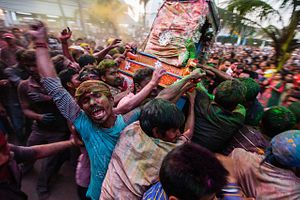For many, Holi is undoubtedly one of the most recognizable and visual festivals in the world. Although most associate it with throwing lots of colored powder in the air, its rituals are filled with symbolism. While the main subject of celebration is the victory of good over evil, every region in India has its own version of these enthralling spring festival celebrations. One region makes human pyramids to steal pots of buttermilk while another has women playfully beating up their men.
In the heart of India’s long-neglected Northeastern states, the town of Barpeta is the center of Neo-Vaishnavism in India. Their take on Holi is called Doul Utsav.
For three or five days, according to astronomical alignments, the statues of Kaila Thakur (Lord Krishna) and Rukmini (Lakshmi) are taken out of their seats and displayed to the public. Thousands of Hindus from across the state travel to pray and receive their blessings. These days are a time for celebration and gathering with loved ones.
On Barpeta’s final day of Holi, only a few days after it is celebrated in other parts of the country, traditional Holi is combined with local traditions. Men and women join to perform Assamese “holigeets,” songs praising Lord Krishna. The statues are paraded around town and swarmed by men, a rambunctious horde fighting to be closest to the gods. When the statues are returned to the temple grounds, they are first taken around the temple seven times while obstructed by disciples of the goddess Lakshmi. After returning to their original seats, Doul Utsav is complete.











































